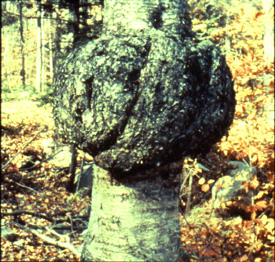
| Home |
| Tutorial |
| Photo Gallery |
| List of Defects |
| Links |
| Bark Distortion |
| Bird Peck |
| Bumps |
| Burls |
| Butt Scars |
| Butt Swells |
| Cankers |
| Conks |
| Epicormic Branches |
| Flanges |
| Flutes |
| Forks |
| Galls |
| Holes |
| Knots |
| Lesions |
| Limbs |
| Ring Shake |
| Rot |
| Seams |
| Soak |
| Splits |
| Wounds |
Significance: Good bucking practice excludes galls from all logs- even the lower classes in which they sometimes degrade the logs. Logs with galls included are hard to load, haul, unload, and process through any type of primary conversion equipment.
In veneer logs, a gall is not a degrader if it causes no more damage than is covered in the definition for a standard defect.
In factory logs, galls always are log-grading defects and also scalable defects because the area occupied by them must be removed from all boards by crosscutting at the trim saws.
In contruction logs, galls are both grading and scalable defects because the disturbance in the grain reduces the required strength for construction material below acceptable limits.
In standing trees, galls that extend beyond one face around the tree circumference of 1 foot (30.5 cm) or more vertically along the trunk are degraders. In identifying stem galls, care should be taken to avoid confusing them with true burls. The gall is rough in appearance, as described earlier, and always a degrader, while the burl is smooth and at times is not a degrader. Although both burls and galls result from excessive cell division and enlargement, the burl shows mostly the wildly contorted grain while the gall also reveals knots, callus, ingrown bark, and stain. Many galls, like true burls, are valuable for cutting into novelties and for sectioning and veneering for decorative panels and inlays.
Galls are fairly common on 11 principal hardwood species. Damaging galls are of two kinds, basal and stem. The most abundant basal gall, sometimes called crown gall, is caused by the bacterium Agrobacterium tumefaciens. It is found mainly in the root system or at or near the root collar of the tree. Crown gall also developes on the upper stem and sometimes on the branches of hardwood trees.
The two major fungal causes of stem galls are Phomopsis spp. and Apiosporina morbosa. The latter produces "black knot" on the branches of black cherry and causes severe stem galls on this species.
Some insect damage is followed by the development of galls, cankers, or lesions. One of the most devastating of these insects is the sugar maple borer (Glycobius speciosus). This insect's attack results in numerous stem galls and some cankers. The wood in the area affected by these galls and cankers is not suitable for any solid wood product.

